#touhou pmiss
Explore tagged Tumblr posts
Text
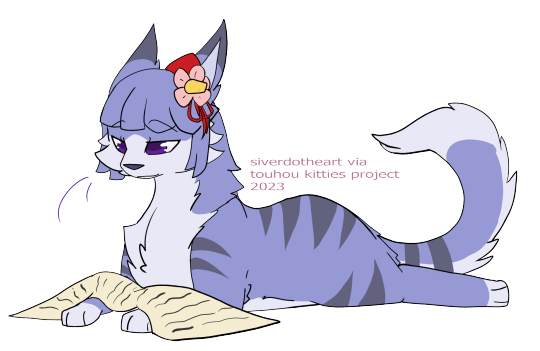
Hieda no Akyuu
#Hieda no Akyuu#touhou#touhou project#touhou Perfect Memento in Strict Sense#touhou PMiSS#Perfect Memento in Strict Sense#Akyuu Hieda#touhou fanart#touhou kitties#touhou kitties project#touhou kitties 2023#art#my art#digital art#cat#cat au
22 notes
·
View notes
Text
You know what. Why do we as a touhou fandom not talk about the fact the pc98 songs are canon. They exist. In canon. Akyuu has them documented and has probably heard them. Someone within touhou's universe wrote them. Reimu could probably actually listen to her own theme. Were the songs actually written about the events of those games?? Was eternal shrine maiden written about reimu?? Was love colored magic written about marisa?? I'm going insane
#i could rant for hours about the fact there is a band in universe that apparently wrote them#thats mentioned in akyuus untouched score and pmiss#i might make a longer post about this eventually im just. obsessed with this fact#ive been rotating this in my brain for over a year i have so many thoughts about it augghhh#im just. honestly not super confident talking about my interpretations of obscure touhou lore#since im kinda worried that ill be wildly misinterpreting something#especially considering i cannot read japanese and translations arent always reliable#but god. i havent seen almost anyone talk about this and i think the implications are very very interesting..#touhou#touhou project
265 notes
·
View notes
Text
The whole dragon god of Gensoukyou plot point being essentially dropped from importance in Touhou is probably because ZUN's pulling less from Kwaidan's Hourai and more from his own ideas when worldbuilding nowadays. On the other hand, he came up with his own, unrelated Important Dragon, so it all evens out, I guess?
#it's probably not that it doesn't exist but that it's nowhere near as much of a hinge of that place's existence as pmiss implied#touhou fans really should read kwaidan
14 notes
·
View notes
Text
Ever since Clarste stopped answering asks I have become the most knowledgeable touhou poster. All others are clad in the folly of fanworks, I alone maintain a pure mind, free of thinking about Aka Yakumo or that the characters are getting older and Akyuu is about to die. I am unsullied, full of only righteous wisdom- I sound like if Zamasu was a touhou nerd
#anyway ask me anything about touhou I have absorbed so much knowledge about it#guy who has actually read PMiSS and BAiJR and AFiEU and-
3 notes
·
View notes
Text
when i say "engaged with" i mean: when you first learned of touhou, what was the thing you decided to engage with first. (example: "I saw a touhou character in the wild, so I decided to read Wild and Horned Hermit to learn about it. Therefore, I engaged with the official manga first!")
153 notes
·
View notes
Text
I've mentioned a few times by now that my interpretation of Yukari Yakumo is that she's secretly still a human being, so I guess I could probably stand to actually explain it.

So, this is what the Perfect Memento says about Yukari. The actual canonicity of PMiSS is in flux, I think, it was written in a much earlier era of Touhou when ZUN seems to have had a somewhat different vision of things and not all of it has remained consistent even accounting for that it's deliberately inaccurate, but we'll ignore that for now. Making strong assertions about something as clay-like as canon in Touhou is a losing game, in any case.
Akyuu's claims seem to check out. We can, actually, independently verify that Yukari does not collect fear from Gensokyo - most characters seem to be only vaguely aware of her at best (and the more they know her, generally, the less they respect her) and in Forbidden Scrollery we see that the human villagers are so unaware of her that showing up to a ghost story circle and telling a story about very specific identifying features like her gaps only provokes confusion.
On the other hand we haven't been shown any of her activities in the outside world. We cannot verify that she collects fear there. More importantly, Akyuu can't verify that.
A youkai that never attacks humans is by definition not a youkai. The youkai Yukari does not attack humans in Gensokyo. Therefore Yukari is attacking humans somewhere else.
That's the logic here. Akyuu is faced with two facts that don't fit together, so she invents something that resolves them. But she doesn't know anything. This may not be true, and if it is, it's of no relation to Akyuu's claims.
We could formulate this problem differently, if we were inclined to.
A youkai that never attacks humans is by definition not a youkai. Yukari, who claims to be a youkai, does not attack humans. Therefore Yukari is not a youkai.
That she's human specifically is a particular leap of mine because I like the idea. I like what it says about Yukari as a character and about her particular situation. And we know from Sakuya that humans can be immortal without ceasing to be human. But looked at with as close to dispassion as I can manage, the evidence is probably weighted more in the direction of her being the Hakurei God. Depending on how you interpret certain dialogue in Missing Power, she comes within an inch of outright saying it, even.
There's also that Yukari and Reimu have long been shown to have different expressions of the same essential powers over borders, boundaries, and other distinctions. This would tend to support the idea that Yukari is the Hakurei God, but I like to fit it into the "Yukari is human" hypothesis by just saying that she's the shrine maiden of the Outside World's Hakurei Shrine. After all, we know it exists, and based on what Rinnosuke saw of it - assuming Yukari's telling him the straightforward truth about what he saw - clearly someone's taking care of it.
Regardless, by presenting one interpretation, Perfect Memento also provides the evidence and uncertainties that make up that interpetation. In doing so, it opens up entirely contradictory interpretations. The wonderful thing about the arts is that the same material can be taken so many different directions. We are obliged to admit that [1 + 1 = 2], but nothing compels us to submit to [youkai ^ !fear -> elsewhere] when [youkai ^ !fear] could mean any number of other things.
#touhou#touhou project#yukari yakumo#yakumo yukari#maribel hearn#and speaking of reimu and yukari sharing powers... nemuno also has those powers#which I have headcanons about but I'd rather express those in art and narrative than in rambling so#in general I think I'm going to try expressing my headcanons in that way more often#a queue in the dark beguiles me#headcanon
108 notes
·
View notes
Note
do you have any insight on the lesser known touhous? maybe someone like sekibanki ? I’d love to hear what you think about touhous you normally don’t get the chance to talk about
I ALSO WOULD LOVE TO GET TO TALK ABOUT MORE OBSCURE TOUHOUS. sekibanki is very interesting but in a similar way to the other early stage bosses in ddc. the goal of the antagonists of ddc is to overturn society and so the first three youkai you meet are like. the classics. they're the most youkai-like of youkai. but not only that, they're both western and japanese at the same time; youkai who could easily fit into either setting with a slight tweak of their species name (mermaid/ningyo, rokurokubi/dullahan, werewolf/...werewolf)
on top of that, they're abnormal, gensokyo-specific instances themselves. you begin with a freshwater mermaid, and move onto a village-dwelling youkai, and then a forest dwelling ex-human youkai. in picking fairly generic youkai for his opening cast, zun nonetheless added enough twists on them to make them relatively distinct entities. and then, of course, he added in the casual mention that they actually know each other, and that was enough for people to take that and run with it.
as for banki herself... the idea of a youkai-like youkai, especially one as famous as a rokurokubi (she's hardly in the same level of obscurity as chiyari, after all), who lives in the village is interesting in itself, but as another lens of looking at the dynamic of the village and the youkai. we know that youkai visit it, we know it's known that youkai visit it (thanks to pmiss), but at the same time there's been a gradual shift away from that tidbit of lore in fs and le. sekibanki seems to me as not quite a compromise as a subversion; a youkai who lives in the village, but who nobody knows is a youkai. i wonder what she does? i wonder how she lives? i wonder what her reputation among the villagers is? youkai are usually antisocial beings, so i wonder how well she escapes that? or does she still have the reputation of a strange loner?
actually now i think about i think it'd be neat if banki showed up in lotus eaters at some point. but that'll probably never happen now that the cast's fully established. alas!
37 notes
·
View notes
Text
Perfect Memento in Strict Sense: Pages 48-51 - Yukari Yakumo
Youkai of Boundaries
Yukari Yakumo
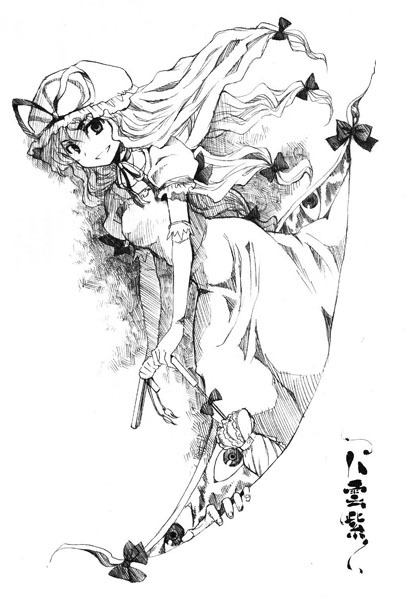
Ability: Manipulation of boundaries
Threat level: Unknown
Human friendship level: Normal
Main place of activity: Anywhere and everywhere
When talking about youkai-like youkai, the first name that comes to mind is probably Yukari Yakumo.
To start with, she is a youkai that you do not want to deal with. Even besides the fundamental issue of the danger of her ability, this youkai will appear anywhere unexpectedly, her character is lacking in human sentiment, and her behavioral principles are completely different from those of humans, to name a few of her issues.
Her appearance is not especially different from that of a human.
She prefers extravagant clothes, and is often seen with a large parasol.
Her main time of activity being at night, she sleeps in the daytime.
All in all, she is a traditional youkai (*1).
Though she claims to hibernate through the winter, we have only her word on it and it's unknown where she lives, so this is unconfirmed.
There is an article in the Youkai Encyclopedia from Aichi's (*2) Gensokyo Chronicle from long ago that seems to describe her.
It appears she existed back then as well.
Ability
The ability to manipulate boundaries is a terrifying ability capable of fundamentally undermining reality.
As far as we know, everything is built upon the existence of boundaries.
If there was no water surface, there could be no lake.
If there was no sky line, neither mountain nor sky could exist.
Were it not for the Great Barrier, even Gensokyo itself wouldn't exist.
If there were no boundaries, everything would probably exist as a single enormous object.
Thus, the ability to manipulate boundaries is by logic an ability of creation and destruction.
It essentially creates a new existence, or conversely rejects some existence.
Among the abilities youkai are known to possess, this is one of the most dangerous, being comparable even to the power of gods.
She is also capable of moving to an entirely separate location between gaps in space, whether it be her entire body or only a part of her.
It's said that this ability is not limited to physical space, but also applies to pictures, others' dreams, and even stories.
In addition, she possesses superhuman (*3) intellect, especially concerning mathematics.
Furthermore, due to her long lifespan, she has a wealth of knowledge and experience.
Daily Life
She is actually quite talkative, and is willing to teach you about herself or about Gensokyo.
However, most of her stories are impossible to prove or confirm, so no one can say how many of them are true.
Her house is said to be located at the boundary between Gensokyo and the outside world, just like the Hakurei Shrine, but no one has ever actually seen it.
This is because she moves through gaps in space, so she seems to appear out of nowhere and disappear into nothing.
No one can follow her through the gaps, so it's not known if it's true or not (*4).
In addition, she rarely does things herself, leaving all of her day-to-day work to a beast youkai she controls as a shikigami instead.
This shikigami acts in her place while she is sleeping, particularly during the day or in winter.
Also, as she has lived a long life, she has many youkai friends that are similarly long-lived.
Most of her friends are youkai of the strongest class, like Yuyuko Saigyouji of the Netherworld and the oni Suika Ibuki (both described later).
Connection to Gensokyo
Gensokyo is isolated from the outside by a large magical barrier.
This barrier could be seen as the boundary separating the inside and outside.
However, the outside world and Gensokyo are still physically contiguous, so it could perhaps be said that the boundary that the barrier forms is what logically defines the place that we call Gensokyo.
In other words, one could say that with the mere existence of the youkai of boundaries, it's possible for places like Gensokyo to be created and destroyed.
It could be claimed that the fact that a youkai of boundaries lives somewhere unknown in Gensokyo, a land surrounded by an enormous boundary, implies that she must have some deep, vital connection to its formation.
Strangely, this youkai rarely attacks humans.
A youkai that never attacks humans is by definition not a youkai, so it is assumed that she does somewhere.
As she can freely visit the outside world, it's speculated that she attacks humans in the outside world (*5).
Anecdotes About This Youkai
Genso-Lunar War
This is a story from over 1000 years ago.
It is said that she once invaded the moon by modifying the boundary between truth and falsehood and plunging into the moon's reflection on the lake's surface.
Although she went in with an army of impudent youkai, they were crushed by the Moon's advanced weaponry.
It is believed because of that incident, youkai usually do not choose to attack outside their territory.
The stories of this event are also what made her powers widely known among humans.
Youkai Expansion Project
A story from over 500 years ago.
The project refers to a plan designed and implemented by Yukari in order to restore power to the youkai of Gensokyo, who felt pressured by the increase in the human population.
Until then Gensokyo was merely a spot deep in the mountains in the middle of nowhere, but she planned to create a boundary of illusion and reality around Gensokyo, logically creating a new world.
By establishing Gensokyo as an illusionary world, and the outside as the real world, the youkai weakened by the outside world would naturally flock to Gensokyo; this was a truly epochal event.
With this, it ended up that even youkai from outside of Japan immigrated to Gensokyo.
The effects of the boundary continue even now.
The cleverness of the plan lies in allowing youkai to disappear in the outside world while permitting them to thrive within Gensokyo.
As long as the outside world remains in the hands of the humans, Gensokyo will remain in the hands of the youkai.
The Great Barrier Commotion
This, of course, refers to the existence of the Great Hakurei Barrier (*6).
It is said that this youkai was one of the sages who suggested the creation of the Great Barrier and created what is now Gensokyo.
However, it appears that in the beginning there was some opposition to this plan from a number of youkai, and there was open conflict between them.
As this conflict distracted youkai from their normal attacks against humans, the Great Barrier has received great praise among the humans of Gensokyo.
Eventually, word of the usefulness of the Great Barrier circulated among the youkai, and there are scarcely any that oppose its existence now.
The Phantom Commotion
The Phantom Commotion refers to the weakening of the boundary between the Netherworld and the world of the living, which has made it easy for the respective denizens of each to cross through it.
It is obvious it was the doings of this youkai.
Since this was the act of a wise youkai, it's possible there was some extraordinary benefit to youkai society in doing this. (*7)
As this is an ongoing incident, the matter remains unresolved.
Eyewitness Reports
"She makes my food disappear right out from under my nose, even when I'm careful about it. I wish she'd stop." (Reimu Hakurei)
When you're not looking she can slip her hand through a gap in space and take things from far away.
"She keeps poppin' into my house and I wish she'd cut it out. Can't she at least use the door like a normal person?" (Marisa Kirisame)
Even playing with teleportation has its limits.
Countermeasures
She seldom appears in the human village.
Barring unknown circumstances, she likely doesn't attack normal humans very often.
No matter how confident one is in their abilities, it would be wise not to attempt to exterminate this youkai.
Though, she would likely make allowances for the power of her opponent so as not to allow the battle to become too one-sided.
In any case, there is neither any sort of defense against nor weak point in the ability to manipulate boundaries.
Her intellect far surpasses those of humans, and her physical strength is what you would expect from a youkai.
Humans probably don't even have a one in a million chance of winning against her.
Excepting, of course, the countermeasure of approaching her in a polite manner.
*1: Recently, as the number of nocturnal humans increases, so does the number of diurnal youkai.
*2: The Gensokyo Chronicles written by the first member of the Hieda line, more than 1200 years ago.
*3: She's a youkai, so it's no wonder she is superhuman.
*4: There are rumors her house is located in the outside world.
*5: There are other rumors that she is a youkai from the outside world, and she simply comes to here for play. Indeed, she may spend the winters and the daytime, when she claims to be sleeping, in the outside world, and some even say that the world in Yukari's dreams IS the outside world.
*6: The boundary separating Gensokyo and the outside world. It's a logical boundary, but it is said to have become extremely difficult for humans and youkai alike to pass through it, so it's clearly a strong boundary.
*7: I have been unable to confirm this in my lifetime.
#touhou pmiss#perfect memento in strict sense#touhou#touhou project#project shrine maiden#yukari yakumo#yakumo yukari#i never quite understood how one would manipulate boundaries until i read this
63 notes
·
View notes
Photo
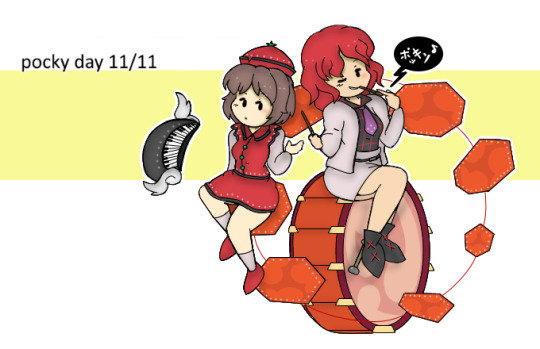


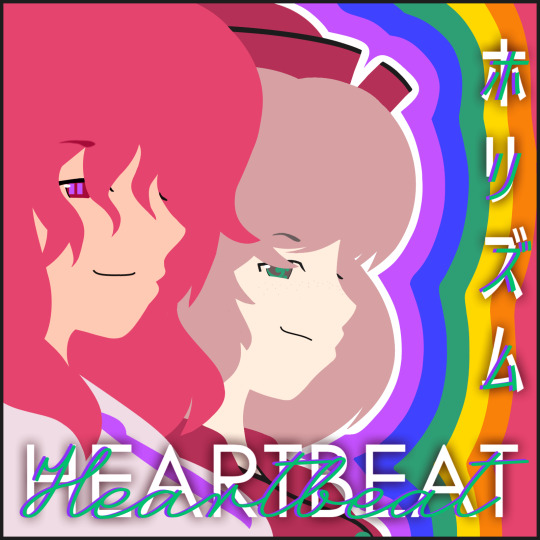

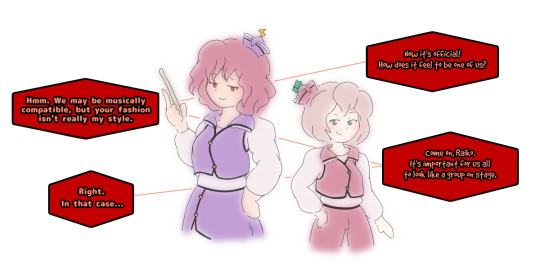

Compilation of older RaiLyri art. 🥁🎹
#touhou#railyri#raiko horikawa#lyrica prismriver#prismriver sisters#fanart#i make an arbitrary height chart and then proceed to never follow it#lyrica just keeps getting shorter because extreme height-difference ships are 💯👌#also... i am aware that PMiSS cites merlin as the tallest sister#but i am stubborn and i believe that lunasa is longer and skinnier#merlin simply has brighter posture and stage presence while lunasa is gloomy and hunched#so akyuu and others get the impression that merlin is taller#prismriver with h
64 notes
·
View notes
Photo

touhou soccer is plausible
48 notes
·
View notes
Photo









don’t spoil yourself these cute Akyuus just read Memorizable Gensokyo first (it’s not long)
#blessed art of Aki Eda#my favourite artist in touhou#Hieda no Akyuu#Memorizable Gensokyo#Perfect Memento in Strict Sense#PMiSS#marisa kirisame#reimu hakurei
12 notes
·
View notes
Text
Thinking about the art by Monoji Tsukuri in PMiSS Their way of drawing the characters is so nice, sad that it doesnt seem like they ever worked on touhou stuff again


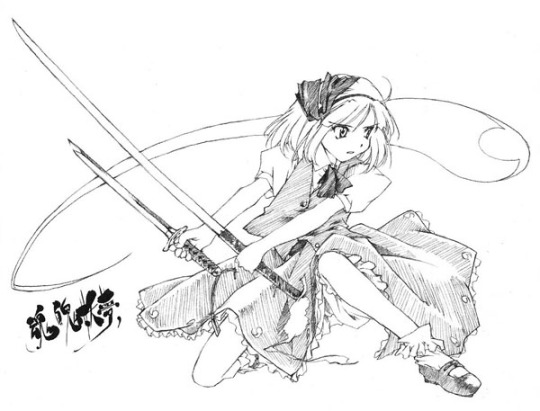


339 notes
·
View notes
Note
What are the things in lore you would say ZUN 100% retconned/later ignored in regards to his own material?
This was a pretty broad question to answer at the drop of a hat, so I let it sit in my inbox for a while and wrote down a couple things that came to mind in the meantime.
As we all know, yadda yadda, Touhou is very good at simply not bringing things up again, and thus you can very rarely argue that some individual thing has been outright retconned based simply on its absence in later works. Add unreliable narrators on top, and that only really leaves the very clear contradictions.
Early Windows stuff: You can surely find more if you crawl more carefully than I felt like doing, but here’s some that I remember. The EoSD prologue tells us that Gensokyo is just a seldom visited region in the mountains with a few random humans living amongst monsters, implicitly no Human Village, and no barrier around it. Reimu is worried that the red mist would basically flow out of Gensokyo and into what we'd now consider "the Outside World", which may or may not be aware of Gensokyo and just ignoring it. It's not hard at all to slot into the current setting by moving around a couple things, but read on its own without anachronistic assumptions it's clearly different. Basically, it's a good example of how the essentials of Gensokyo as a setting really weren't fully formed until at least a couple games later.
As an extension of that, I think a lot of things associated with EoSD - like the preceding Vampire Incident, the spell card rules, or even the SDM being newcomers to Gensokyo - weren’t even a twinkle in ZUN’s eye at the time he made EoSD, and were only retconned into existence starting roughly with PMiSS. (Them being newcomers is arguable based on stuff like Reimu not knowing the mansion was there, but that’s also easily explained by Reimu being Reimu.)
PCB starts fleshing things out a bit more and has fewer outright contradictions, but still for example claims/implies that humans sealed up Gensokyo in order to lock the youkai inside. Not irreconcilable, especially if you assume an unreliable narrator yadda yadda, but I think it’s fair to consider it retconned.
By the time of IN, the main pieces are more or less in place and there’s a lot less stuff that would need to be retconned later on, but you can still find some messiness especially related to the Moon if you want to read it that way.
Reimu’s luck: While it’s come up on rare occasion, typically in the form of her “intuition” but also in LE where she uses it for gambling, I don’t think it’s ever again been anywhere near as extreme as that time in EaLND where she walked over a river by happening to step on random fish. If anything, she usually seems pretty unlucky at everything that isn’t specifically gambling or solving incidents, but that might be its own hair to split.
Just for bonus points: Since it’s been on my mind. The literal meaning of retcon is “retroactive continuity”. I think the manga, games etc. typically work on a Schrödinger’s Timeline that simply doesn’t exist until it is directly referenced somehow, and even then it’s only loosely defined. For example, CDS and Lotus Eaters started around the same time (in real life), which was also when the first Gouyoku Ibun demo came out. Lotus Eaters could be making long time skips for all we know, but the events of CDS have probably spanned only a couple weeks at most.
And now we have Lotus Eaters' latest chapters taking place shortly after the events of Gouyoku. In that case, when Yukari summons Flan into the Underground to act as her ballistic missile in CDS, is she doing it before or after Okina did literally the same thing in Gouyoku? When does CDS take place in relation to Gouyoku, or any given LE chapter? Or does it, and every Touhou story, merely take place “now”, even if it started in 2019 and it’s now 2023?
Since Touhou stories tend to only reference each other when they feel like it and are otherwise perfectly comfortable just not bringing it up in any way, there’s a good chance we’ll never know. Or they could simply say something in the next chapter just because. But usually not.
63 notes
·
View notes
Text
now granted, concealed the conclusion (whose conclusion i have just unconcealed and am about to continue unconcealing for you) was a semi-reasonable game to make at its time (2006). there was speculation about gensokyo all being someone's dream in PMiSS (released at the same time), the butterfly dream schtick in CoSD. making the main character reimu as a terminally ill child is very very silly when the point of reimu is that she's not in control of anything, much less the entire world (but works of that time loved to overstate reimu's importance, so you know. some people even thought that gensokyo would be destroyed if she died, in actual canon).
the problem with it (besides some rather dreadful mischaracterizations that didn't even fit with the limited canon of the time) is that it then stuck around in the consciousness of touhou fandom in the west for a decade, far, far longer than it did on side JP. and good god it stuck around too long on side JP too- it is a distinctly pre-MoF game (early windows vagueness is a death knell for fanon) yet people were talking about it seriously in 2015, when i started hanging around on shrinemaiden. and even after that, for a good while! it only really started falling off in 2019-20.
oh and also it had some really bad music remixes.
#war stories#the plot of the game is of course that terminally ill reimu dies and gensokyo is destroyed because it was all her dream
41 notes
·
View notes
Text
I wish other people were as interested in the history of the development of touhou because it's got such great stories within it.
The fact ZUN approached writing Perfect Memento in Strict Sense with his typical "I'll just give it a shot and see what happens, lol" mindset until he met a publisher at a Cafe to discuss the book and they asked "So what do the people in your world eat, where do they get it, how is it made? What do they wear, where do they get the clothes how are those made? Where do they live, who built the homes, what are they made of? If you cannot answer these questions you cannot write this book."
The fact he took that to heart and starting with touhou 10 (the first made after PMiSS) there's clearly more thought put into the where and why of everything, characters having more distinct goals and wants and homes, more distinct mythological and folkloric origins, a place within the world that they fiil their way, an impact on that world that makes them known. They're not a prop in a game, the necessary target for you to shoot at, they're a person in a world who was doing something before this fight and will go do other things after.
7 notes
·
View notes
Text
GHOSTS
Usual threat level: Very high Frequency of encounters: Low Variety: Low Places likely to be encountered: Anywhere Times likely to be encountered: Anytime
CHARACTERIZATION
The souls of the dead who don't realize that they have died or whose unwillingness to recognize death is too strong will be unable to achieve nirvana, becoming ghosts. Ghosts are different from phantoms, since they keep the appearance they did while alive, can touch and speak, and can't be told apart from a normal human by a casual observer. Their body temperature isn't low, and the only living things that can become ghosts are humans.
As a large number of ghosts are unable to traverse the river, they remain in the realms of the living, or cross over to the Netherworld or to Hell. In any case, there is absolutely no chance of reincarnation.
If you become a ghost one day, until you accomplish your objective or your body is ceremoniously buried, you won't achieve nirvana (*1).
Ghosts can easily influence the human heart with just their voices, so it is dangerous to carelessly talk to one. Ghosts who carry grudges are a particularly dangerous threat, so you should somehow find the body (*2) and have the burial ceremony; therefore, a ghost's weak point is its body (*3).
Ghosts hide their corpses and never reveal them to people. They don't have bodies of flesh, but they aren't as insubstantial as phantoms, so they can touch things. On the other hand, they find it difficult to pass through objects (*4).
However, since they don't have physical bodies, even if they can touch objects, they cannot be injured.
POTENTIAL HARM ( Madness, Being Turned into a phantom )
The scariest thing is that they live alongside humans and can't be discerned as ghosts by the untrained eye. Even if the ghosts don't have any ill will, if you're touched by one of the dead, before you know it you'll be beckoned by death.
Also, there are cases in which the ghost is a family member or friend, so people hesitate to hold a memorial ceremony and instead go on living together.
At first, it may seem like a happy thing to continue living together after someone dies, but the ghost is disconnected from the cycle of reincarnation, not only will they wander for eternity, but they'll soon realize that their entire family has died.
Even more frightening are ghosts who carry grudges.
The take on the form of humans and deceive the living. Until the grudge is fulfilled they will haunt people to death.
1: If they haven't realized that they're dead, they sometimes vanish upon finding their bodies. 2: The corpse. 3: Since the corpse can't move. 4: Because many of them believe that they are still alive.
- excerpts from Perfect Memento in Strict Sense; GHOSTS
#PERFECT MEMENTO in STRICT SENSE (Information)#//#figure I put this here#this is basically just 'ghosts' in the Touhou universe like#not all of it applies in every ghosts only the ones in the Touhou universe#so basically it's just one type????? of ghosts??????#this is probably one of the main reasons why I enjoy roleplaying Yuyuko so much like-#she's soft and sweet and whimsical yes#but also#official supplementary works also states that they're not exactly as 'benevolent' as your regular garden-variety of ghosts#I would probably put Yuyuko's PMiSS entry later if ever#or add it in my existing dossier#depends we'll see#tonight on 'Icchan gdi you need to stop fangirling on Yuyuko'
4 notes
·
View notes